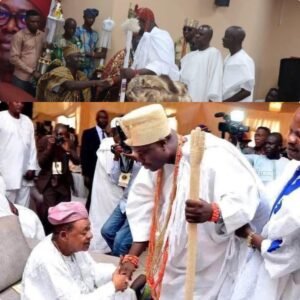
By Ibrahim Kegbegbe
While it’s often said that a journalist should know something about everything or everything about something, I, Ibrahim Taofeek Kegbegbe, write within my jurisdiction in weighing in on this traditional matter. As a trained journalist who studied the History of Nigeria during my National Diploma programme and History of Africa during my Higher National Diploma course at the Nigerian Institute of Journalism, I have a firm grounding in the cultural and historical foundations upon which these debates rest.
That said, any flaws in interpretation are mine alone. But where this article aligns with historical accuracy and public reasoning, credit rightly belongs to my lecturers, mentors, and the scholarly materials I have consulted.
The recent social media uproar over a viral video showing the present Alaafin of Oyo, Oba Abimbola Akeem Owoade, remaining seated while greeting the Ooni of Ife, Oba Adeyeye Enitan Ogunwusi (Ojaja II), has reignited a long-standing debate: who is the superior monarch in Yoruba tradition — the Alaafin or the Ooni?
A second image has also resurfaced, this time capturing the late Alaafin of Oyo, Oba Lamidi Adeyemi III, similarly seated while exchanging greetings with the current Ooni. These scenes have stirred polarized reactions, with many Nigerians weighing in based on cultural sentiment, historical narratives, and perceived royal protocol.
But to understand this sensitive matter objectively, we must step back into history and reexamine the thrones these two revered monarchs occupy.
Historical Context: The Thrones of Power and Spirit
Oba Lamidi Adeyemi III, who reigned from 1970 until his death in 2022, was the 45th Alaafin of Oyo. He sat atop a throne that once governed a formidable empire — the Oyo Empire — which held sway over much of Yorubaland and beyond from the 15th to the 19th centuries. Politically, the Alaafin was the military and administrative head of this vast dominion, making the position historically imperial in nature.
On the other hand, Oba Okunade Sijuwade (Olubuse II), the late 50th Ooni of Ife, and his successor Oba Ogunwusi, represent the spiritual ancestry of the Yoruba people. The Ooni’s throne is rooted in Ile-Ife — the cradle of Yoruba civilization — and regarded as the seat of Oduduwa, the progenitor of the race.
While the Alaafin’s title is borne of imperial conquest and political control, the Ooni’s authority stems from divine ancestry and spiritual reverence. In essence, one rules the land, the other rules the soul.
Legal Equality vs. Traditional Supremacy
In modern-day Nigeria, all traditional rulers are considered equal under the law. Their relevance is largely symbolic and cultural, recognized within their specific domains and accorded privileges by state governments.
Yet, some federal archival records tell an older story. As early as 1938, official colonial documentation graded Yoruba Obas by salary and status, placing the Alaafin of Oyo at the top of the hierarchy — £4,200 — well above the Ooni of Ife, who earned £1,400.
These figures were more than monetary; they reflected administrative influence at the time. Today, however, these distinctions are obsolete under the Nigerian constitution, which treats all monarchs without legal superiority.
The Controversial Greeting: Mere Gesture or Hidden Message?
In the viral video and photos in question, the Alaafin remained seated while the Ooni approached. Culturally, some interpret standing to greet another king as a sign of respect, especially in Yoruba etiquette where elders and status are symbolically honored.
Yet others argue that royal greetings among equals may vary based on context, personality, and precedent.
Importantly, this is not the first time such an interaction has occurred. During Oba Lamidi Adeyemi’s reign, a similar scene was recorded — further emphasizing that this might be more than a matter of disrespect. It could be a reflection of the Alaafin’s historical consciousness of his imperial status.
Still, critics argue that mutual respect among Yoruba monarchs should transcend ego or throne, especially in modern Nigeria where unity and tradition are paramount.
A Call for Understanding, Not Rivalry
Rather than pit one revered monarch against another, Yoruba people and Nigerians at large should embrace the complementary roles both thrones play. The Alaafin embodies the proud legacy of Yoruba political ascendancy; the Ooni preserves the sacred ancestral bond that binds the Yoruba identity.
Standing or sitting should not overshadow the deeper truths these thrones represent — one of unity in diversity, heritage in dignity, and leadership with mutual respect.
The question shouldn’t be “Who is greater?” but rather, “How do we honor both history and heritage in a way that unites rather than divides?”
The Alaafin and Ooni are both custodians of Yoruba greatness — one carries the sword of empire, the other the staff of divinity. Let the people honor both, and let our kings lead with grace, not grievance.
















